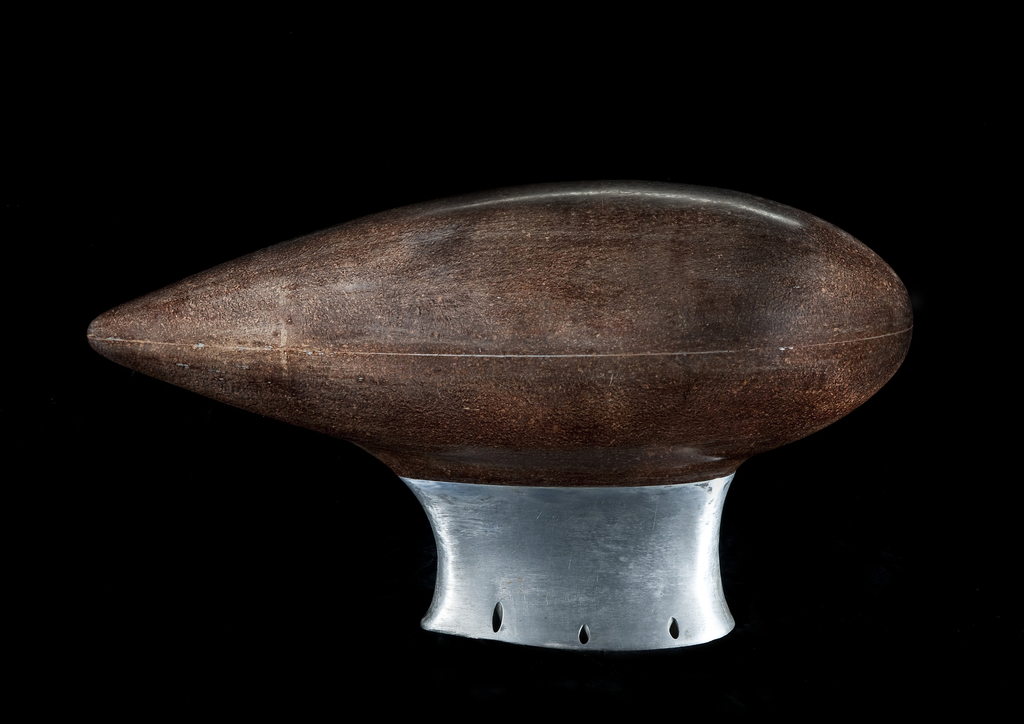See more objects with the color darkolivegreen black dimgrey dimgrey darkgrey or see all the colors for this object.
Object Timeline
|
|
|
-0001 |
|
|
1935 |
|
|
1945 |
|
|
2014 |
|
|
2025 |
|
Radio Compass Loop Antenna Housing (USA)
This is a Radio Compass Loop Antenna Housing.
This object is not part of the Cooper Hewitt's permanent collection. It was able to spend time at the museum on loan from National Museum of American History as part of Tools: Extending Our Reach.
This radio-antenna used for navigation was found on the exterior of most airplanes during World War II. Earlier radio-direction-finder antennas from the 1920s and ‘30s, consisting of wire coils over a circular form, imparted substantial aerodynamic drag; metal housings were not ideal because they disrupted signal reception. This so-called "football," made of Bakelite, the first totally synthetic plastic, became the answer to the problem. Bakelite was lightweight, transparent to radio waves, resistant to heat, cold, water, as well as most acids, and was a superb electrical insulator, all critical for aviation design. Created by Belgian chemist Leo H. Baekeland in 1907, Bakelite was used in airplane parts as early as World War I. It was a powered resinous material that could be molded into any shape and could not be melted or remolded. This radio-antenna housing is molded from cloth-filled Bakelite, which provides strength and increases its moldability.
It is credited Smithsonian Institution, National Museum of American History, 1977.0368.65.
- Flight Data Recorder F1000 ("Black Box") (USA)
- epoxy-glass circuit cards, integrated-circuit chips, integrated connectors,....
- Smithsonian National Air and Space Museum, Gift of Loral Data Systems,....
- 16.2012.14
- Radio Nurse Transmitter Radio Transmitter
- bakelite (tm), metal, electronic components.
- Gift of Mel Byars.
- 1991-59-61
- Model 400-1 Patriot Radio Radio
- phenolic resin (opalon), urea plastic, cellulose acetate, acetate, metal.
- Gift of George R. Kravis II.
- 2014-10-1-a,b
Our curators have highlighted 3 objects that are related to this one.
- Purma Special Camera
- bakelite (tm), acrylic, metal.
- Gift of Barry Friedman and Patricia Pastor.
- 1986-99-24
- Drawing, Rendering of K4s Class Locomotive with Final Placement of Winged...
- graphite on white tracing paper.
- Gift of the Pennsylvania Railroad through Samuel M. Vauclain.
- 1937-58-4
- Drawing, Design for Placement of Pennsylvania Railroad Keystone Logo on K4s...
- graphite on white tracing paper.
- Gift of the Pennsylvania Railroad through Samuel M. Vauclain.
- 1937-58-5
Its dimensions are
H x W x D: 35 x 23 x 67 cm (13 3/4 x 9 1/16 x 26 3/8 in.); from Reg. office L x Diam.: 26 in. x 9 in. Streamline housing with mount bracket
This object was previously on display as a part of the exhibition Tools: Extending Our Reach.






